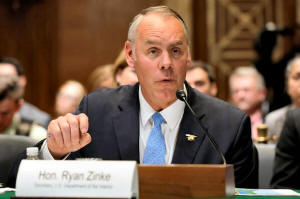|
Environmentalists slam Interior chief
Zinke over Yellowstone chief's ouster
 Send a link to a friend
Send a link to a friend
 [June 09, 2018]
By Laura Zuckerman [June 09, 2018]
By Laura Zuckerman
PINEDALE, Wyo. (Reuters) -
Environmentalists on Friday accused the Trump administration of
political interference and retaliation in the ouster of Yellowstone
National Park's chief after his disputes with U.S. Interior Secretary
Ryan Zinke over the park's celebrated bison.
Dan Wenk, who has led one of the nation's premier parks since 2011, on
Friday described as "punitive" the decision by Zinke that he should
retire early or be reassigned to a post in Washington, D.C.
Wenk said in an interview he was not given specific reasons for the
ultimatum, which came after he had announced his intention to retire in
2019. He said he had had disagreements with Zinke about the number of
bison at the park but had believed those to be resolved.
Environmentalists were quick to accuse Zinke of selling out parks,
public lands and wildlife in the West to oil and gas developers,
sportsmen and ranchers, among others.

"His decision to force out the superintendent of the world's first
national park should be seen for what it is: political interference and
retaliation for a Park Service leader standing up for parks and wildlife
rather than special interests," the Sierra Club's Bonnie Rice said in a
statement on Friday.
The fracas over Wenk's ouster is the latest controversy surrounding an
Interior secretary who has been reviled by conservationists but hailed
by industry and conservatives in Western states, where local governments
have chafed against restrictions imposed on federally protected areas.
REVIEW OF MONUMENTS
Zinke, a former Montana congressman, sparked controversy last year after
reviewing more than two dozen national parks and protected areas,
indicating some could be scaled back to allow for more hunting and
fishing, as economic development.
The review has cheered energy, mining, ranching and timber advocates but
has drawn widespread criticism and threats of lawsuits from conservation
groups and the outdoor recreation industry.
The National Parks Conservation Association said diverse sides should be
represented when it comes to places like Yellowstone.
"Dan Wenk stood up for wildlife and united voices around solutions and
we need to ensure that same approach will continue," Bart Melton, a
regional director for the group, said on Friday.
Interior Department spokeswoman Heather Swift did not respond to a
request for comment about criticism leveled at the secretary and
declined to directly respond to Wenk's belief his removal from the park
was a form of punishment.
[to top of second column]
|

U.S. Interior Secretary Ryan Zinke testifies before a Senate
Appropriations Interior, Environment and Related Agencies
Subcommittee hearing on the FY2019 funding request and budget
justification for the Interior Department, on Capitol Hill in
Washington, U.S., May 10, 2018. REUTERS/Yuri Gripas/File Photo

Wenk said Yellowstone bison should be managed like wildlife rather
than livestock and the herd's size should not be solely determined
by ranchers who live outside the park in Montana. He added there was
no basis to assertions that a segment of Yellowstone's rangelands
had been adversely affected by grazing bison rather than natural
processes.
A ranchers association said it was "steadfast" about keeping the
bison population at 3,000. The bison population is now around 4,000.
"We feel that number is realistic and sustainable and not only meets
the needs of the park in reducing migration of bison outside its
boundaries but also reduces the threat of the possible transfer of
disease to domestic cattle," said Jay Bodner, executive vice
president of the Montana Stockgrowers Association.
BRING SCIENCE TO ISSUE
If Zinke was concerned about overgrazing in the park, Wenk said he
sought to answer it by suggesting science should be brought to the
issue.
"It's okay to have differences of opinion and I thought we were
working through those," he said.
Environmental groups and tribes have been critical of the park's
years-long practice of sending bison to slaughter for wandering from
Yellowstone into neighboring Montana in search of food in the winter
as a method of controlling the population of the nation's last herd
of wild, purebred bison.

The policy is a concession to ranchers who worry bison exposed to
brucellosis, a disease that can cause cows to miscarry, might infect
cattle that graze outside the park, though such a case has never
been documented in the wild.
Millions of American and international visitors crowd the park each
year to view wildlife like bison and natural wonders like the Old
Faithful geyser.
(Editing by Bill Tarrant and Sandra Maler)
[© 2018 Thomson Reuters. All rights
reserved.]
Copyright 2018 Reuters. All rights reserved. This material may not be published,
broadcast, rewritten or redistributed.
Thompson Reuters is solely responsible for this content. |